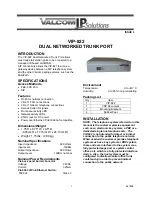
Transition Networks, Inc.
S4224 Web User Guide
33595 Rev. C
Page 643 of 669
Ethernet ring node
A network element which implements at least the following functionalities:
a
) One Ethernet connection function (ETH_C) with a dedicated Ethernet flow forwarding function (ETH_FF) for
forwarding ring automatic protection switching (R-APS) control traffic.
b
) Two ring ports, including ETHDi/ETH adaptation function at the ring maintenance entity group level (MEL).
c
) Ethernet ring protection (ERP) control process controlling the blocking and unblocking of traffic over the ring
ports. Per ITU-T Rec.G.8032/Y.1344 (03/2010).
Ethernet Services
Generally refers to Metro Ethernet Services available from service providers (SPs) per MEF specifications (MEF
6, Ethernet Services Definitions, and MEF 10, Ethernet Services Attributes).
Ethernet Type
Ethernet Type, or EtherType, is a field in the Ethernet MAC header, defined by the Ethernet networking
standard. It is used to indicate which protocol is being transported in an Ethernet frame. See “Commonly Used
EtherTypes” above.
EUI-64
The 64-bit Extended Unique Identifier (EUI-64) in IPv6.
EVC
(Ethernet Virtual Connection) An association of two or more UNIs that limits the exchange of frames to UNIs in
the EVC. Generally, an EVC allows Ethernet service frames to be exchanged between UNIs that are connected
via the same EVC. Per MEF 6.1, EVC performance requires “At least one CoS is REQUIRED. MUST specify
CoS ID, per section 6.8 of [2]. MUST list values for each of the following attributes {Frame Delay, Frame Delay
Variation, Frame Loss Ratio, and Availability} for each CoS, where Not Specified (N/S) is an acceptable value.”
F
Fast Leave
Multicast snooping Fast Leave processing allows the switch to remove an interface from the forwarding-table
entry without first sending out group specific queries to the interface. The VLAN interface is pruned from the
multicast tree for the multicast group specified in the original leave message. Fast-leave processing ensures
optimal bandwidth management for all hosts on a switched network, even when multiple multicast groups are in
use simultaneously. This processing applies to IGMP and MLD.
















































